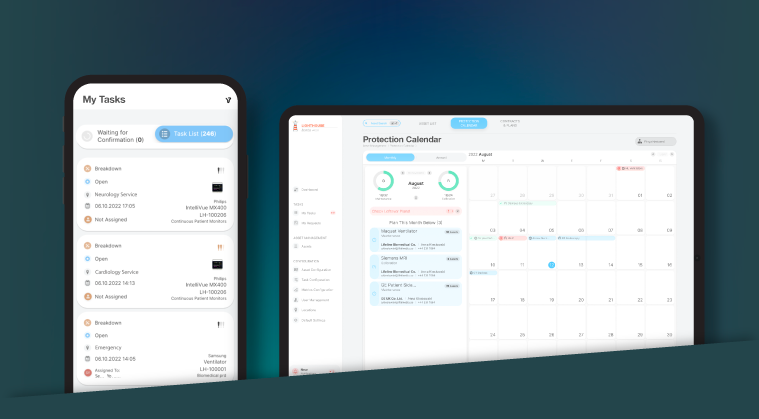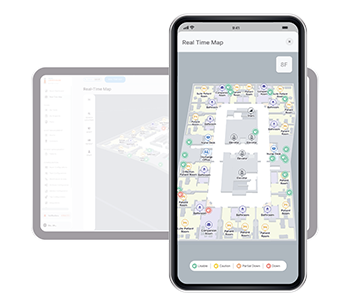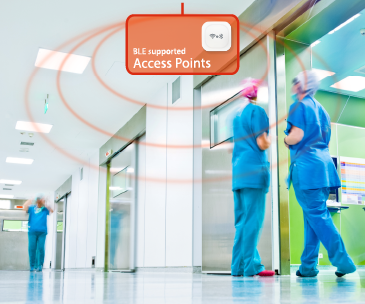
Hospital RTLS Using Your Own WiFi Access Points: No Extra Infrastructure
Hospital RTLS Using Your Own WiFi Access Points: No Extra Infrastructure
In today’s fast-developing healthcare environment, real-time tracking of assets, patients, and staff is essential for maximizing operational efficiency and improving patient care quality. Traditionally, deploying Real-Time Location Systems (RTLS) has required investment in dedicated infrastructure, creating financial and logistical barriers for many hospitals. However, a new approach leverages existing BLE-supported WiFi access points, enabling hospitals to implement robust RTLS solutions without the need to commission additional hardware. This method dramatically cuts costs and reduces operational disruptions, allowing hospitals to rapidly deploy the system and start benefiting from real-time tracking immediately.
RTLS & BLE-Supported WiFi Access Points for Zone-Level Tracking
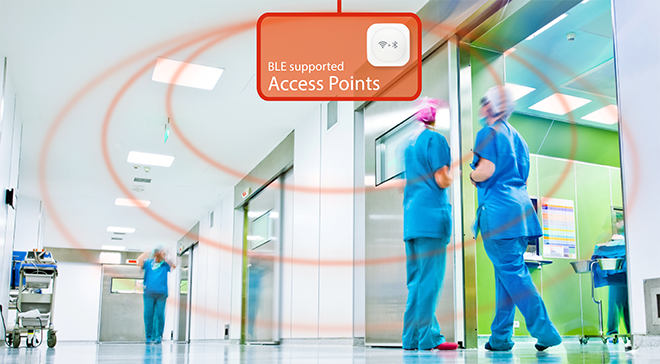
RTLS technology enables real-time tracking of assets, patients, and staff within hospitals. By using Bluetooth Low Energy (BLE) based tags and BLE-supported WiFi access points, hospitals can monitor locations and movements at a zone level, enhancing operational efficiency and improving patient care. Bluetooth Low Energy (BLE) is a wireless communication technology known for its low power consumption and high efficiency. Modern wireless access points often come equipped with BLE capabilities, enabling them to detect signals from strategically placed BLE beacons. This integration allows hospitals to implement comprehensive RTLS solutions using their current WiFi infrastructure.
The Benefits of Leveraging Existing Infrastructure
- Significant Cost Savings: Utilizing existing BLE-supported WiFi access points eliminates the need for new infrastructure, making RTLS implementation more affordable. Hospitals can redirect funds typically allocated for new hardware toward other critical areas of patient care and facility improvement.
- Minimized Operational Disruption: By using the existing WiFi network, hospitals can deploy RTLS solutions with minimal interference, ensuring a seamless transition that does not disrupt daily activities or compromise patient care.
- Faster Deployment: Leveraging existing infrastructure allows for quicker deployment of RTLS solutions. Hospitals can swiftly begin to benefit from real-time tracking capabilities, enhancing efficiency without the lengthy installation processes associated with new systems.
- Scalability and Flexibility: Existing WiFi networks provide a scalable foundation for RTLS solutions. As the hospital’s tracking needs grow, additional BLE beacons can be easily integrated, allowing the system to expand without major overhauls.
Application Areas
Asset Management and Utilization through Asset Tracking
Leveraging hospital RTLS for asset management and utilization through existing access points in hospitals offers significant advantages in operational efficiency and cost-effectiveness. By utilizing BLE-supported access points already in place, hospitals can track the real-time location of critical assets such as wheelchairs, infusion pumps, and other essential items at a zone level without the need for extensive infrastructure investments. This seamless integration ensures precise asset tracking, optimizes asset usage, reduces loss, and minimizes the time staff spends searching for necessary assets.
Implementing hospital RTLS through existing access points enhances visibility into asset utilization patterns, allowing for better resource allocation and maintenance scheduling. Hospitals can gain insights into asset usage trends, identify underutilized assets, and make informed decisions to improve operational workflows. Additionally, this technology can significantly improve patient care by ensuring that critical assets are always available when needed, thus reducing delays and enhancing the overall efficiency of hospital operations.
Patient Flow through Patient Tracking
Hospital RTLS technology, integrated with existing BLE-supported access points, enables efficient tracking and reporting of patient movements within the hospital. This allows healthcare facilities to monitor and document when patients move from their rooms to the operating theatre or any other department. For example, the system can track if a patient passed through a specific geofence at a certain time, entered surgery, is in transfer, or is on the patient floor.
Using access points already installed throughout the hospital, RTLS provides real-time visibility into patient locations without the need for additional infrastructure. This integration helps streamline patient flow, reducing waiting times and improving the overall patient experience. Detailed reporting of patient movements ensures better coordination among care teams, minimizes delays, and enhances operational efficiency.
What If You Need a Higher Resolution in Tracking?
Tracking accuracy can vary based on a hospital’s specific needs. Using existing WiFi access points, hospitals can achieve effective zone-level tracking, allowing for the monitoring of assets, patients, and staff within broader areas such as specific wings or departments. This level of tracking is sufficient for many applications, like ensuring that asset is in the right department or monitoring general patient movement between floors. While utilizing BLE-supported WiFi access points for RTLS provides a cost-effective solution for zone-level tracking, there are scenarios where higher resolution is necessary. Accurately pinpointing the exact room where a critical asset is located or determining a patient’s precise location within a few feet can significantly enhance operational efficiency and safety.
Room-Level Accuracy for Staff Duress, and Patient Wandering & Safety
For applications requiring higher resolution, implementing Borda Locator with BLE Angle of Arrival (AoA) technology can provide hospitals with sub-3-foot accuracy. This high-precision tracking is crucial, especially for safety solutions such as staff duress and patient wandering & safety applications.

Staff Duress and Safety solutions allow hospital staff to make an emergency call from anywhere in the hospital with the touch of a button on their Staff Tags. Upon pressing the panic button, a white code alarm is activated and promptly transmitted to security personnel, providing precise, pinpoint location information of the staff duress incident. Security personnel can immediately respond to the exact real-time location, ensuring a swift and precise intervention
Patient wandering and safety solutions enable the definition of specific areas within the facility as authorized zones. When a patient wearing an RTLS Patient Tag approaches or crosses a predefined boundary, the system triggers alerts. For example, if a dementia patient wearing an RTLS tag approaches an exit door, an alert is generated, allowing staff to intervene. Regarding patient safety, patients can activate the emergency call system with a simple push of a nurse call button on their wristbands. The system identifies the patient’s pinpoint location, enabling nurses to reach them faster than ever before.
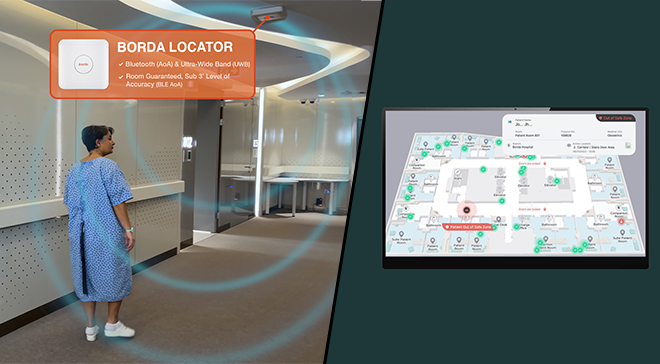
Hospitals may need higher resolution for asset management and utilization, enabling them to quickly locate critical assets within a specific room. This reduces the time spent searching and ensures essential asset is always available when needed.
Implementation Steps
1. Infrastructure Assessment: Begin by assessing the hospital’s existing WiFi network. Identify the locations of BLE-supported access points and evaluate their coverage areas. Determine if additional coverage is needed to ensure comprehensive tracking.
2. Configuration of Access Points: Ensure that the existing WiFi access points are configured to detect BLE signals. This may involve updating firmware or adjusting settings to optimize performance for RTLS purposes.
3. Tagging: Label the assets, patients, or staff to be tracked in the hospital with active tags. These tags will communicate with the access points located throughout the hospital, enabling real-time location tracking of the assets, patients, or staff.
4. Mapping: Acquire and configure the hospital’s map to create a format for real-time location tracking. Assets, patients, or staff can be tracked on this map.
5. Integration with RTLS Software: Implement RTLS software capable of processing data from the WiFi access points. This software translates BLE signals into real-time location data, providing valuable insights for hospital management.
6. Testing and Calibration: Conduct thorough testing to ensure the system accurately tracks assets, patients, and staff. Calibrate the system as needed to address any inconsistencies and refine tracking accuracy.
7. Training and Rollout: Train hospital staff on effective use of the RTLS system. Ensure they understand how to interpret data and respond to alerts generated by the system. Promote the benefits of the RTLS solution to encourage adoption and proper usage.
By leveraging existing BLE-supported WiFi access points, hospitals can implement RTLS solutions in a cost-effective and minimally disruptive manner. This approach not only maximizes the use of current infrastructure but also provides significant benefits in terms of safety, operational efficiency, and patient care. As technology advances, hospitals that adopt innovative solutions like this will be better equipped to meet the dynamic challenges of the healthcare industry.


